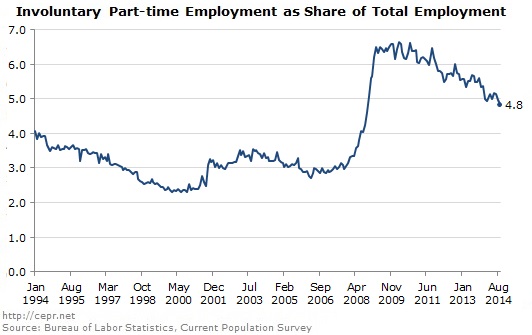October 03, 2014
October 3, 2014 (Jobs Byte)
There has been no acceleration in wage growth even as the unemployment rate has fallen.
The unemployment rate in September fell by 0.2 percentage points to 5.9 percent. This is the first time it has been below 6.0 percent since July of 2008. It has fallen by 1.3 percentage points over the last year. While employment is up by 2,330,000 over the last year, much of the decline in the unemployment rate is due to people leaving the labor force. The labor force participation rate is down 0.5 percentage points from its year-ago level. The employment-to-population ratio (EPOP) has risen by just 0.4 percentage points over the last year and has remained fixed at 59.0 percent over the last four months, more than 4.0 percentage points below its pre-recession level.
The data in the establishment survey also showed a strengthening labor market. The economy added 248,000 jobs in September. This growth, along with upward revisions to the prior two month’s data, brings the 3-month average to 224,000. The gains were broadly based, but the biggest gainers were retail (35,300), employment services (33,600), health care (22,600), professional and technical services (21,100), and restaurants (20,400). None of these figures are in any obvious way anomalous, although a jump of 19,500 in jobs in food stores, compared to a gain of 49,500 over the prior year, is not likely to be repeated. There was an increase in employment in state government education of 21,500 in September. This is likely a seasonal adjustment issue since employment reportedly fell by 8,400 over the prior two months.
Construction added 16,000 jobs in September, roughly even with its 19,000 average over the last year. Jobs in the sector are still down by more than 1.6 million from pre-recession peaks. There was no clear trend in manufacturing as the sector gained 4,000 jobs, reversing the 4,000 jobs lost in August. Employment is up by 161,000 from year-ago levels, but there is little clear momentum in the sector.
On the household side, the sharpest drops in unemployment were a 1.0 percentage point drop for black women, from 10.6 percent to 9.6 percent and 0.5 percentage points for white men, from 4.9 percent to 4.4 percent. The unemployment rate for black teens fell by 2.3 percentage points from 32.8 percent to 30.5 percent, although this number is highly erratic. The unemployment rate for Hispanics fell by 0.6 percentage points to 6.9 percent, the same as in the early months of the recession.
By education level, workers with less education have been the biggest gainers. The unemployment rate for workers with just a high school degree fell by 0.9 percentage points in September to 5.3 percent. It is now 2.2 percentage points below its year-ago level. The unemployment rate for workers without high school degrees fell by 0.7 percentage points to 8.4 percent, two full percentage points below its year-ago level. By comparison, the unemployment rate for college grads is 0.8 percentage points below its year-ago level at 2.9 percent, almost 50 percent higher than its pre-recession level. While the EPOPs for high school grads and those without degrees both rose over the last year, the EPOP for college grads is down by 0.1 percentage points.
The number of people choosing to work part time rose slightly and now stands 642,000 above its year-ago level. This presumably is the result of people taking advantage of the Affordable Care Act and getting insurance through the exchanges or expanded Medicaid rather than their employers.
While the number of people involuntarily working part-time fell by 174,000 in September, it is still extraordinarily high given the unemployment rate. As a percent of the labor force it is still far above the level at any point in the last recession or even at the start of 1994 when the unemployment rate was 6.6 percent. (The question was changed in January of 1994, so older data are not consistent.)

Slow wage growth also suggests labor market slack. Wages have grown at a 2.0 percent annual rate over the last three months, the same as their rate of increase over the last year. In addition, the share of unemployment due to quits is just 8.9 percent, compared to a rate of 11-12 percent before the recession and 13-14 percent in the late 1990s. In short, while the labor market is improving, it still has a long way to go before reaching full employment.






